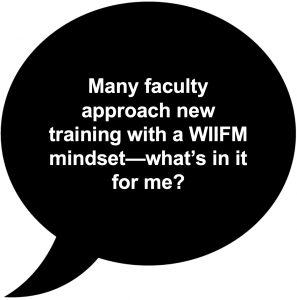Author and Editor: Dr. Denise Lowe
Dear ADDIE,
I’m in our on-boarding meeting and I can see it in my subject matter expert’s eyes. The telltale signs of upcoming resistance – eyes not meeting mine, arms crossed, and lots of silent sighs. They are saying everything’s fine, there have no questions, and they’re “looking forward to it.” From past experience, I know I will have missed deadlines and sub-optimal submissions when I get them. I usually have success in overcoming the resistance, but not until very late in the development process. Many times, I have to involve their dean in getting cooperation as well. I feel as though if I could overcome this earlier, we could be more productive and get to our milestones on time. Given that our SMEs are contracted to create a “master” course for the college and agree to use our development process which includes planning and alignment (YIKES!), what are some ways to head off the resistance earlier in the process?
Signed,
Resistance is Futile
Dear Resistance,
Overcoming faculty resistance to professional development training for online course design is a common problem for many instructional designers. Although resistance can be an impediment to the working relationship between the faculty member and instructional designer, it can also be a catalyst for faculty to further develop their craft—if it can be navigated successfully.

Faculty may find the entire online process overwhelming due to their lack of familiarity with technology, or they may feel that other tasks are a priority, and they don’t have time for the training. Conversely, as experts in their discipline, they may simply not understand or appreciate the role of the instructional designer in learning a different approach to teaching.
Most of us, as instructional designers, are excited about our online professional training programs, and we want to share this with our faculty. However, this may come across as a series of dictates or tasks that must be accomplished in the program; for some, this can feel like an “outsider” is
trying to tell them how to teach the content of which they are the expert,
especially if they are required to complete the training or have significant concerns about the integrity and credibility of online learning.
You may find it helpful to begin by inviting the faculty member to talk about their teaching styles and experiences. For example, how do they engage the students in a face-to-face course? What teaching styles do they currently use to further the critical thinking of students? By inviting faculty to talk about themselves first—something most of us love to do—creates an atmosphere that respects their knowledge and experience.
Often, this approach is a stepping stone to discuss the concerns that some faculty have about the online environment and process of course design. As those concerns are shared, the instructional designer can offer the tools, technologies, and best practices that may address their concerns. By keeping the focus on applied concepts—something with which most SMEs are very familiar—the credibility and usefulness of the instructional designer and the online training program is enhanced.
Many faculty approach new training with a WIIFM mindset—what’s in it for me? It’s a good idea for the instructional designer to look through that lens as well, in order to anticipate potential resistance. Are there incentives for completing this training? Will this help in promotion and tenure? Another aspect to consider is the potential benefit to students, usually a solid reason why they became faculty in the first place.
If all of this sounds like basic communication practice, you’re right! Building rapport with the faculty member is essential to creating the right environment for learning to occur. In the course design process, faculty become students—a role in which they may not have undertaken in some time. Identifying and using faculty experiences, providing peer engagement and administrative support, and understanding the obstacles and opportunities that online learning provides work together to build effective communication—essential elements in overcoming resistance.
I’m sure there are many more tips that others in the community have found useful. What strategies do you use for effectively engaging faculty in the online course design process? Please share your thoughts with our TOPkit community on LinkedIn!
